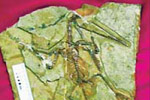Odd News
Giant crayfish found in Tennessee is new species
Updated: 2011-01-20 10:37
(Agencies)
WASHINGTON - A new species of giant crayfish literally crawled out from under a rock in Tennessee, proving that large new species of animals can be found in highly populated and well-explored places, researchers said on Wednesday.
The new crayfish should not have been easily overlooked, as it is huge - twice the size of other species, the team at the University of Illinois at Urbana-Champaign and Eastern Kentucky University said.
| ||||
"This isn't a crayfish that someone would have picked up and just said, 'Oh, it's another crayfish,' and put it back," said University of Illinois aquatic biologist Chris Taylor, one of the researchers.
"You would have recognized it as something really, really different and you would have saved it," Taylor added in a statement.
Taylor and Guenter Schuster of Eastern Kentucky University found their first specimen of the new species under one of the biggest rocks in the deepest part of a commonly explored Tennessee creek.
The new species, called Barbicambarus simmonsi, is about 5 inches (12 cm) long and has antennae covered with a sensitive fringe of tiny, hair-like bristles, called setae.
More than half of the 600 known species of crayfish in the world are found in North America, Taylor said.
"This thing had not been seen by scientific eyes until last year," he said.
We spend millions of dollars every year on federal grants to send biologists to the Amazon, to Southeast Asia - all over the world looking for and studying the biodiversity of those regions," Schuster said. "But the irony is that there's very little money that is actually spent in our own country to do the same thing. And there are still lots of areas right here in the U.S. that need to be explored."
Specials

President Hu visits the US
President Hu Jintao is on a state visit to the US from Jan 18 to 21.

Ancient life
The discovery of the fossile of a female pterosaur nicknamed as Mrs T and her un-laid egg are shedding new light on ancient mysteries.

Economic Figures
China's GDP growth jumped 10.3 percent year-on-year in 2010, boosted by a faster-than-expected 9.8 percent expansion in the fourth quarter.


